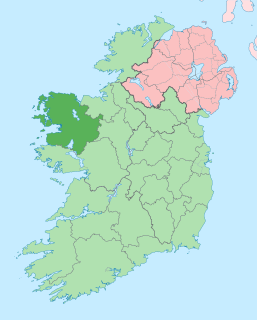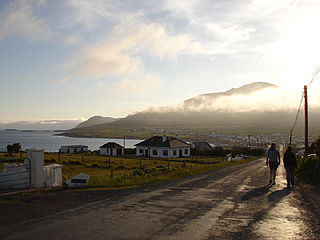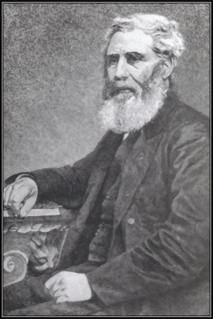
Achill Island in County Mayo is the largest of the Irish isles, and is situated off the west coast of Ireland. It has a population of 2,594. Its area is 148 km2 (57 sq mi). Achill is attached to the mainland by Michael Davitt Bridge, between the villages of Gob an Choire and Poll Raithní (Polranny). A bridge was first completed here in 1887. Other centres of population include the villages of Keel, Dooagh, Dumha Éige (Dooega), Dún Ibhir (Dooniver), and Dugort. The parish's main Gaelic football pitch and secondary school are on the mainland at Poll Raithní. Early human settlements are believed to have been established on Achill around 3000 BC. The island is 87% peat bog. The parish of Achill consists of Achill Island, Achillbeg, Inishbiggle and the Corraun Peninsula.

County Mayo is a county in Ireland. In the West of Ireland, in the province of Connacht, it is named after the village of Mayo, now generally known as Mayo Abbey. Mayo County Council is the local authority. The population was 137,231 at the 2022 census. The boundaries of the county, which was formed in 1585, reflect the Mac William Íochtar lordship at that time.

The Church of England is the established Christian church in England and the mother church of the international Anglican Communion. It traces its history to the Christian church recorded as existing in the Roman province of Britain by the 3rd century and to the 6th-century Gregorian mission to Kent led by Augustine of Canterbury.

The Great Famine, also known as the Great Hunger, the Famine or the Irish Potato Famine was a period of mass starvation and disease in Ireland from 1845 to 1849, which constituted a historical social crisis which had a major impact on Irish society and history as a whole. With the most severely affected areas in the west and south of Ireland, where the Irish language was dominant, the period was contemporaneously known in Irish as an Drochshaol, loosely translated as "the hard times". The worst year of the period was 1847, known as "Black '47". During the Great Hunger, roughly a million people died and more than a million fled the country, causing the country's population to fall by 20–25%, in some towns falling as much as 67% between 1841 and 1871. Between 1845 and 1855, no fewer than 2.1 million people left Ireland, primarily on packet ships but also steamboats and barque—one of the greatest exoduses from a single island in history.

Irish Canadians are Canadian citizens who have full or partial Irish heritage including descendants who trace their ancestry to immigrants who originated in Ireland. 1.2 million Irish immigrants arrived from 1825 to 1970, and at least half of those in the period from 1831 to 1850. By 1867, they were the second largest ethnic group, and comprised 24% of Canada's population. The 1931 national census counted 1,230,000 Canadians of Irish descent, half of whom lived in Ontario. About one-third were Catholic in 1931 and two-thirds Protestant.

Mountmellick or Mountmellic is a town in the north of County Laois, Ireland. It lies on the N80 national secondary road and the R422 and R423 regional roads.

Spiddal is a village on the shore of Galway Bay in County Galway, Ireland. It is 18 kilometres (11 mi) west of Galway city, on the R336 road. It is on the eastern side of the county's Gaeltacht and of the Connemara region. According to the 2016 census, 35.3% of the population speak Irish on a daily basis outside the education system. It is a centre for tourism with a beach, harbour, and shore fishing. The village is part of the civil parish of Moycullen.
The Irish Church Missions (ICM) is a conservative and semi-autonomous Anglican mission. It was founded in 1849 as The Irish Church Missions to the Roman Catholics chiefly by English Anglicans though with the backing and support of Church of Ireland clergy and bishops, with the aim of converting the Roman Catholics of Ireland to Protestantism. The reference to Roman Catholics in the title was removed in 2001.

Murrisk is a village in County Mayo, Ireland, on the south side of Clew Bay, about 8 km west of Westport and 4 km east of Lecanvey.

Dooagh is a village located on Achill Island in County Mayo, Ireland. It is best known for the nearby Keem Bay, a Blue Flag beach.
Souperism was a phenomenon of the Irish Great Famine. Protestant Bible societies set up schools in which starving children were fed, on the condition of receiving Protestant religious instruction at the same time. Its practitioners were reviled by the Catholic families who had to choose between Protestantism and starvation. People who converted for food were known as "soupers", "jumpers" and "cat breacs". In the words of their peers, they "took the soup". Although souperism did not occur frequently, the perception of it had a lasting effect on the popular memory of the Famine. It blemished the relief work by Protestants who gave aid without proselytising, and the rumour of souperism may have discouraged starving Catholics from attending soup kitchens for fear of betraying their faith.

Doohoma or Doohooma is a townland, peninsula and a census town in County Mayo, Ireland. It is located on Ireland's Atlantic coastline overlooking Achill Island and the Mullet Peninsula.
The Christian Brethren of Malaysia, sometimes simply called the Brethren, are an aggregate of independent and autonomous Protestant Evangelical Christian churches in Malaysia, which are networked together through a set of shared Biblical doctrines and practices. Most of these churches are associated with the faith and practices of the Plymouth Brethren movement that arose in the late 1820s.

William Richards was a missionary and politician in the Kingdom of Hawaii.
Tóin an tSeanbhaile is a small village located on the north east point of Achill Island, Ireland. It lies within the Mayo Gaeltacht.
Achill Missionary Herald and Western Witness (1837-1869) was an Irish Provincial Newspaper.

The Church of Jesus Christ of Latter-day Saints has had a presence in the island of Ireland since at least 1840, when the Mormon missionary John Taylor first preached in Newry. He and other missionaries converted a number of Irish people, forming a branch in Hillsborough, County Down. Many of the converted Irish saints emigrated in order to escape poverty, as well as to live in majority Latter Day Saint communities. Missionary efforts continued in the 1850s and a small branch was established in Dublin, but many members emigrated to Utah or lost interest in the church, and in 1867 the Irish mission was placed in the care of the British mission. A new branch was formed in Belfast in 1884 and a Dublin branch was reestablished in 1900. All of this occurred despite anti-Mormon disturbances by local Irish people.

Edward Nangle was a Church of Ireland minister and the founder of the Achill Mission Colony. He established a Protestant mission on Achill Island, County Mayo, in 1834 and worked there for eighteen years with the aim of bringing Protestantism to the Native Irish Christians who were impoverished in large part due to the Penal Law policies of the Protestant Ascendancy. Edward Nangle was involved in evangelical attempts to convert Catholics to Protestantism. He opened a Christian school on the island where children were taught reading, writing, agricultural skills and Christianity as part of a Missionary Colony. His presence on the island led to some press coverage and parliamentary debates. The island itself was developed with a pier built at Dugort, a courthouse at Achill Sound and a road network between numerous key locations on the island. A plaque hanging in St. Thomas Church, Dugort, dedicated to Edward Nangle and erected by friends after his death, reads: "He devoted his life from the year 1834 to the welfare of the people of Achill among whom he lived for many years."
Bridget Patricia Byrne is an Irish writer of narrative nonfiction. Two of her books deal with historical events in nineteenth-century Achill Island.















